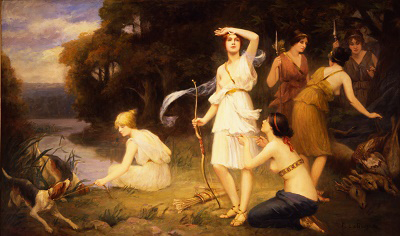Fernand Le Quesne (French, 1856–1932)
Diana and Her Hunting Maidens
Oil on canvas, 40 x 65 3/4 in.
Signed lower right: F. Le Quesne
1996.4

Fernand Le Quesne studied with academic artists Henri Gervex (a founding member of the splinter Société Nationale des Beaux-Arts, which broke from the official Salon in 1890) and Albert Maignon (who remained loyal to the official Salon des Artistes Français into the 20th century). Le Quesne principally created history paintings, portraiture, and genre scenes, including imaginative recreations of historical places and events, frequently depicting attractive, often nude, women—either as allegorical figures or quasi-mythological characters. Like his teacher Maignon, Le Quesne exhibited at the Salon des Artistes Français, and became a member of that society in 1891. He received awards at the Salons of 1889, 1893, and 1894 and, in 1900, a silver medal at the Universal Exhibition in Paris for The Founding of Saint Louis (ca. 1900, Old Courthouse, St. Louis, Missouri), which he exhibited again four years later at the Louisiana Purchase Exposition in St. Louis, Missouri in 1904. The exhibition handbook singled that painting out as one of the French works that visitors would “doubtless be attracted by…because of its local interest as well as its intrinsic charm.” Le Quesne also exhibited in England, showing his work at the Royal Academy in London in 1913 and 1918.
In Diana and Her Hunting Maidens, Le Quesne presents what could almost be described as a genre scene of hunting peopled with classical figures. The goddess of the hunt, Diana (identified by her bow and the crescent moon on her forehead), stands prominently at the center of the composition, attended by her maidens, who kneel before Diana to hand her a golden arrow, mind the leashed hunting dogs, and inspect the goddess’s recent kill, their spears still in hand. Unlike most artists from the late 19th and early 20th century, Le Quesne depicts Diana as the goddess of the hunt, rather than the nude immortal caught off-guard at her bath by the young hunter Actaeon. According to Ovid’s Metamorphoses, Actaeon happens upon Diana while she is at her bath with her nymphs. Diana, startled and enraged by the young hunter’s appearance, turns Actaeon into a deer, and he in turn becomes hunted prey. The theme of Diana’s Bath became an increasingly popular subject for artists (for example, Jules Joseph Lefebvre’s Diana, Luc-Olivier Merson’s Diana, and René Menard’s The Bath of Diana, all in the Dahesh Museum of Art collection), because of the opportunity to depict the female nude as a respectable classical subject. Le Quesne’s Diana, however, is fully clothed, and his scene avoids any overt reference to the Actaeon story, thus departing from the 19th-century vogue for Bathing Dianas. Le Quesne created at least one other, slightly smaller version of his Diana and Her Hunting Maidens (private collection).


